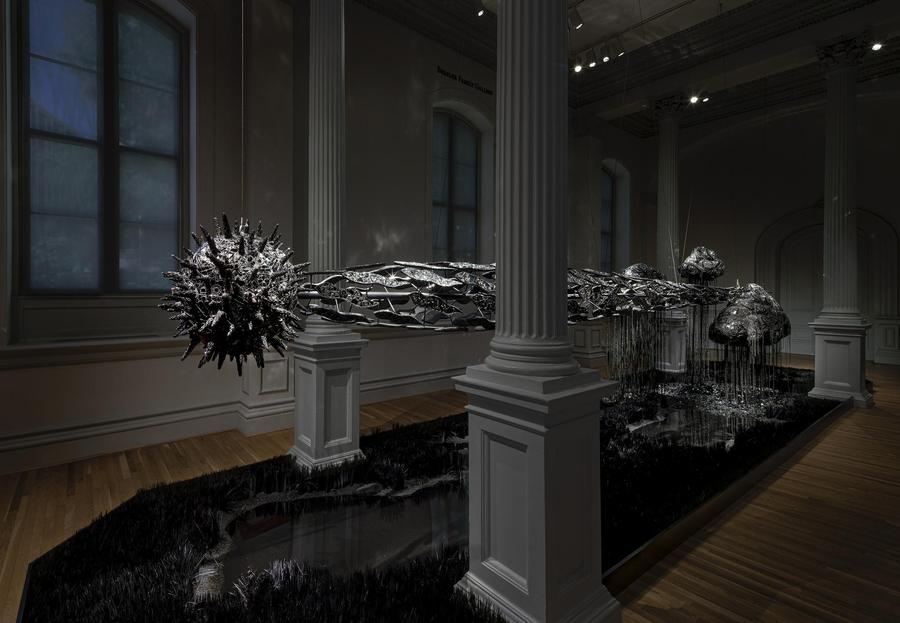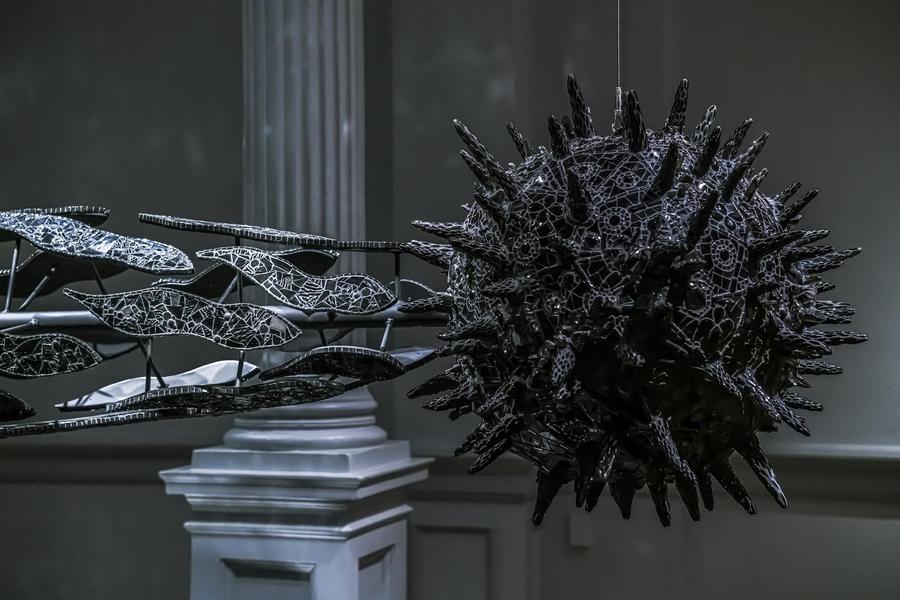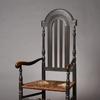Artist Lauren Fensterstock Will Transform Chrysler Museum Gallery Into a Dark and Glittering Cosmos
- November 08, 2021 10:41

Lauren Fensterstock’s The Totality of Time Lusters the Dusk, on view at the Chrysler Museum of Art Jan. 15–June 19, 2022, invites visitors to come face to face with a dark and ominous cosmic landscape. A black comet—encrusted with a dazzling mosaic of glass, crystals, and stones including onyx and hematite—hovers at eye level and bursts through a collection of dark clouds; rain falls in streams of glass and crystal beads, pooling on the ground into puddles of reflective black Plexiglas and surrounded by an earthy black landscape dotted with paper plant forms.

This installation is the first in Fensterstock’s newest body of work, which reflects how humans have manipulated the natural world to express their cultures, views and values. Her works explore how weather and celestial activity have been used as a metaphor, which is an especially potent idea in our current age of extreme weather and changing climate. Although this new direction came before COVID-19, the foreboding and destabilizing beauty of Fensterstock’s work takes on additional meaning amidst the devastating global pandemic.

The Totality of Time Lusters the Dusk was originally commissioned by the Smithsonian American Art Museum’s Renwick Gallery for its 2020 invitational exhibition Forces of Nature. Fensterstock was one of four artists selected for the Renwick Invitational, a prestigious biennial series that aims to introduce the work of exceptional artists who are established in their respective craft fields yet are worthy of greater recognition. The installation was meant to be on view at the Renwick Gallery June 2020–Feb. 2021, but the exhibition was delayed and then open for only a short time due to the COVID-19 pandemic.

“We are thrilled to bring this mesmerizing installation to the Hampton Roads region,” says Carolyn Swan Needell, Ph.D., the Chrysler Museum’s Carolyn and Richard Barry curator of glass, “Lauren Fensterstock’s work is a brilliant combination of minute detail and great scale, and her work invites the viewer to look closely and think deeply about the role humans play within the earthly and cosmic landscapes.”
Trained as a metalsmith, Fensterstock creates tactile sculptures and large-scale installations that are labor-intensive and materially seductive. She uses techniques that have long histories in the fields of craft and decorative arts, techniques that are also often called “women’s arts.” This includes paper cutting, quilling, mosaic and shellwork. Fensterstock’s early artworks centered on conversations about adornment, beauty, preciousness and ephemerality. These ideas developed over the years and now manifest in her recent works, which “explore the narratives we develop to find meaning in nature and the landscapes we fabricate to situate ourselves in the world,” the artist says.
In her investigations of the storms brewing all around us, Fensterstock sources an eclectic mix of references that includes classical Zen texts, medieval European illuminations and Leonard Cohen songs as guides in reading these portents. The newest addition to the artist’s rich catalog of influences is The Book of Miracles, a sixteenth-century luxury manuscript that belongs to a category of apocalyptic albums. This type of publication became popular as more people began reading the Bible in the wake of the development of the printing press. The Book of Miracles details a wide range of events marked by extreme natural conditions, which were believed to be the result of divine intervention: the deluge that necessitated Noah’s ark, plagues of locusts, skies with multiple suns, stars falling from heaven and snow in summer. One image—a fiery comet appearing at the time of Muhammad’s birth over the city of Constantinople—serves as a key reference for The Totality of Time Lusters the Dusk.
Needell notes that Fensterstock’s signature all-black color palette “trains our eyes to see objects and details in a very different way, giving viewers a unique path to reflect upon the overall meaning of the work.” Fensterstock’s work demands close looking, with its dense surface patterns and shiny dark surfaces that throw glimpses of light. The artist says that the highly decorative surfaces of her sculptures “highlight the beauty of a world that may at times be indifferent to us, but is nonetheless beautiful in its complexity.” She harnesses the various material elements in her works to refer to scrying, a practice that uses dark and reflective surfaces to see visions of the future. “With so much turmoil on the ground, I've turned my eyes to the sky for wisdom. Moody storms. Ominous comets. Dying stars,” comments Fensterstock. “Weather events and celestial sightings are a historically rich location for the projection of human anxiety, hopes, and fears.”

This artwork was commissioned by The Renwick Galleries of the Smithsonian American Art Museum for the 2020 Renwick Invitational, on loan from Claire Oliver Gallery, NY and the Artist.



















_-3100x100_c.jpg)

